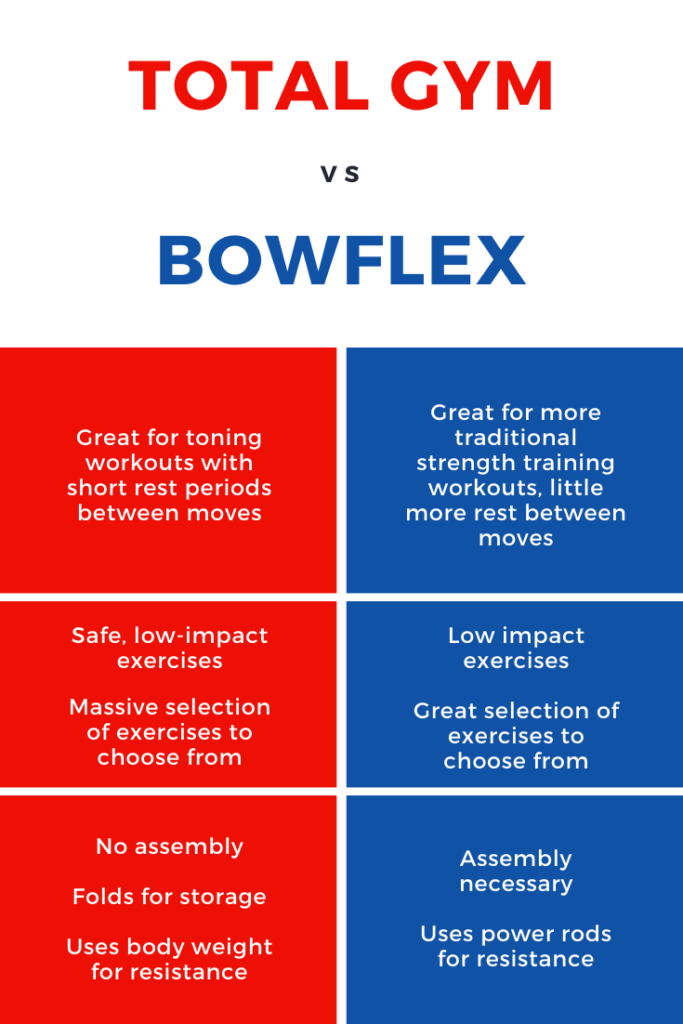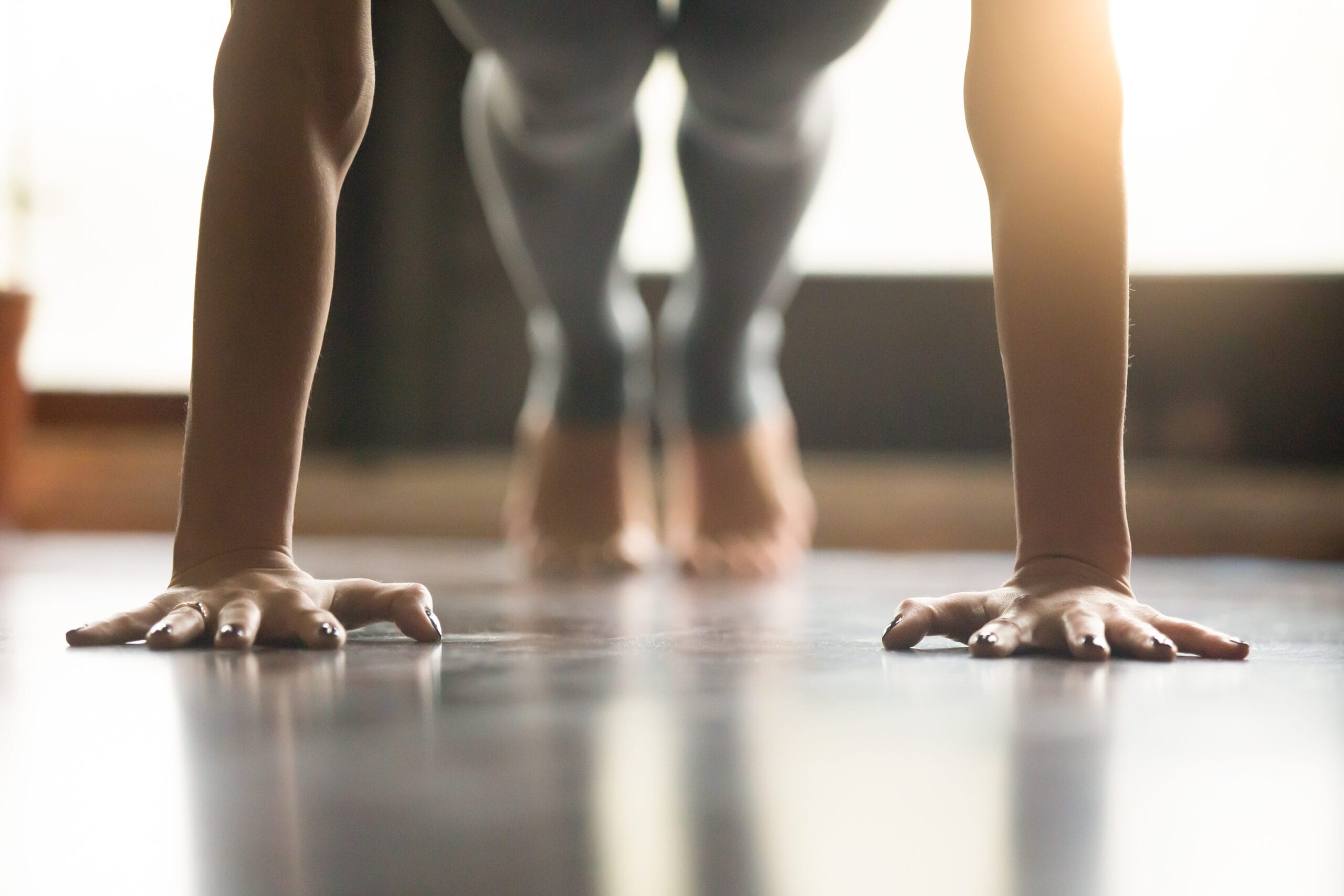
Total Gym and Bowflex are the 2 biggest names in the game when it comes to all-in-one home gym machines. And even though both brands are capable of providing a great full-body workout, they go about it in completely different ways.
On the one hand, Total Gym uses a simple, gravity-based system and your body weight to help you build strength.
On the other, Bowflex uses their patented power rods and a more traditional gym setup to give you everything you need to get in tip-top shape.
Which is better?
Unfortunately, I can’t answer that one for ya- that’s like asking “which is better, apples or oranges?”. It all depends on preference and what you’re going for in your home gym.
What I can do is give you a clear comparison between the 2 brands, so that you can learn as much as possible and decide for yourself which (if either) brand is best suited to help you meet your fitness goals.
Yeah, that sounds pretty good, let’s get started with that.
Total Gym vs Bowflex
Personally, I’m a fan of both of these brands. I think both companies put out great products and you can’t go wrong with either one (as long as you know what to expect with each).
I will say, if someone forced me to choose, and I had to purchase one or the other today, I would probably go with a Bowflex.
And this decision is purely based on my fitness needs and what I would want to get out of it- it has nothing to do with Bowflex being better than Total Gym in any way.
But more on this in a little bit, I actually want to start our discussion with Total Gym.
Total Gym
There’s no denying that the Total Gym is a remarkable success story. The first one came out in 1974 and they’ve been going strong ever since.
Well, it did take awhile for their popularity to hit the masses.
They where more of a hit with athletes and rehab clinics for the first decade or so, but in the ’90s their famous infomercials starting airing and that’s when things got real.
Anyway, the point is Total Gym has earned a stellar reputation for the quality and effectiveness of their gyms over the years.
Years ago, I used them in different rehab facilities I worked at and they were very effective. They work so well for rehab purposes because they are very low impact and the sliding board makes for a gentle way to provide lower body strengthening exercises.
Using your body weight as resistance, you don’t have to worry about changing weights, dropping weights, or finding a spotter.
There have been a lot of different Total Gym models over the years, but they all work the same way:
Each Total Gym consists of an adjustable angle sliding board and a set of pulleys. Your body weight provides the resistance you work against and you can increase or decrease your resistance by adjusting the angle of the slide board- a steeper angle increases the resistance because you’re lifting a higher percentage of your body weight against gravity (and vice versa for reducing that angle).
These home gyms are very simple in design, but they’re also incredibly versatile.
The actual number of exercises you can perform varies depending on the included attachments, but you can perform between 60-80 different moves on most Total Gyms (and upwards of 200 on the commercial grade Total Gym GTS).
Another perk of getting a Total Gym is how easy they are to set up. Most models come pre-assembled, so all you have to do is unfold them and insert a few pins (which takes minutes, as opposed to traditional gyms that take hours).
Total Gyms are easy and safe to use and they offer a ton of workout variety, but they certainly aren’t for everyone.
You can increase the resistance on these machines by increasing the slide board angle, but even then they don’t really provide the type of resistance necessary for advanced strength training.
And by that I mean that these gyms are better for toning and strengthening than bulking up. If you like to do heavy, power lifting style workouts, a Total Gym is not the right piece of equipment for ya.
Instead, I would recommend a Total Gym for someone who is looking for a full body, low-impact workout. Someone who is interested in increasing strength, but without doing high-resistance/low rep style workouts.
Total Gyms are also great for cardiovascular training because you can switch between exercises rapidly, which cuts down on rest time between moves.
And decreasing rest times is a great way to turn any resistance training workout into a cardiovascular workout too.
The pulleys allow for the use of a wide range of motion as well, which is great because you can adapt your motion to fit your fitness level (also helps with flexibility and stabilization).
If you’d like to see more info on the differences between all the Total Gym models, check out my extensive Total Gym Guide.
The specs, like weight capacity and whatnot, vary from model to model, as does the warranty provided by Total Gym (see my guide linked to above for these details).
But generally speaking, Total Gyms come with decent warranties. The higher-end models, like the Fit and XLS, come with lifetime frame guarantees.
And another great thing about a Total Gym is that there aren’t that many pieces that can breakdown- take care of it and these things should last.
Bowflex
Bowflex isn’t quite as old as Total Gym, but it’s been around for a long time too (since 1986 to be exact). Like Total Gym, Bowflex started out with a single home gym machine- one that used “power rods” instead of weight plates or a stack.
Unlike Total Gym, who continues to offer only their home gyms, Bowflex has diversified like crazy. Nowadays, they have a complete lineup of cardio equipment, gyms, and dumbbells.
They’ve also been very innovative over the years, coming up with several new devices the world had never seen before- like their SelectTech Dumbbells and TreadClimbers.
More recently, they’ve even come out with a “stationary” bike that allows you to lean from side to side during your workouts (Bowflex Velocore).
Some companies find success and then just start phoning it in, forgetting about what it was that got them there in the first place- Bowflex isn’t one of those companies.
Their cardio equipment and home gyms are still some of the best in the market, especially for the moderate price range ($2000-$3000).
When it comes to their home gyms, they too offer several models, although not quite as many as Total Gym.
Like Total Gym, most Bowflex gyms use the same general setup with a few subtle differences between the different models (I say most, because the Bowflex Revolution uses a completely different type of resistance).
With the exception of the Revolution, all Bowflex gyms use their patented power rods as the source of resistance.
These polymer rods act kinda like resistance bands, providing a smooth resistance that increases the farther it’s stretched. Some people love this, because a lot of moves are easier at the beginning of the movement and more challenging toward the end.
Purists might not like this, because the resistance changes throughout the arc of movement (unlike dumbbells, which provide a consistent resistance throughout).
The power rods can be combined in different combinations to provide varying amounts of resistance.
Most Bowflex gyms come with 210 lb worth of power rod resistance (and most can be upgraded up to 410 lb).
Bowflex gyms can offer a lot of workout variety too, although not quite as much as the Total Gym. Depending on the model, you’ll be able to perform anywhere from 25-100+ exercises with a Bowflex.
Bowflex’s come in different shapes and sizes. Most come with vertical benches (making them more compact), but some come with horizontal ones (like the Bowflex Blaze).
These gyms can provide comprehensive, full-body workouts that can challenge folks of most fitness levels. Unlike the Total Gym, you can get higher levels of resistance with these systems, making them easier to use for hypertrophy training.
It takes a little longer to switch between exercises on most Bowflex’s, which is fine if you’re doing more of a “lift-rest” type of workout, but you won’t be able to alternate between exercises as fast as you can on a Total Gym.
Another big difference is that there is considerable assembly necessary on Bowflex gyms- these things don’t come pre-assembled unfortunately.
So if you’re weary about assembly, this is something to consider.
The specs and warranties for each Bowflex gym varies, but generally speaking, they come with pretty fair guarantees. Many of their gyms come with lifetime power rod warranties and several years on parts.
For more info on all the specific Bowflex gyms, check out my comprehensive Bowflex Home Gym Guide.
In a nutshell, I think a Bowflex gym would be a good choice for someone looking for more of a traditional home gym machine.
You know, one where you can perform a variety of strengthening moves and that you can select your resistance easily for each exercise.

Final Thoughts
Total Gym and Bowflex are both winners in my book, there’s no wrong answer when trying to decide between these 2 brands.
You should probably go with a Total Gym if:
- you’re looking to improve strength and cardiovascular health
- you’re looking for a low-impact, full-body workout
- you’re looking for the utmost in exercise variety
- you don’t want to mess with assembly
You should probably go with a Bowflex gym if:
- you’re looking for more of a traditional home gym machine
- you like the feel of working with resistance bands
- you’re looking for more intensive strength training
- you’re comfortable with assembly
Alrighty, that about does it. I hope this article was helpful in providing a comparison between the Total Gym and Bowflex home gym machines.
There really are a lot of differences between the 2 and there are a lot of differences between the individual models as well.
If interested, I encourage you to check out my guides for each category, where we go into a lot more detail regarding the differences between the individual gyms.



